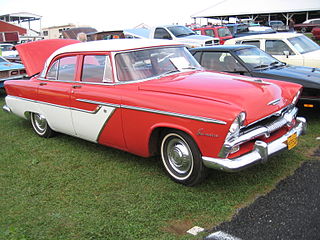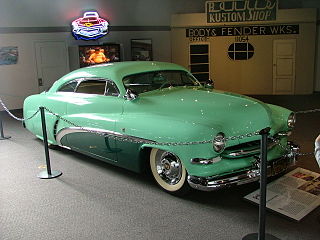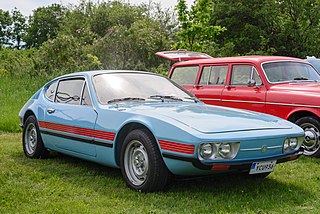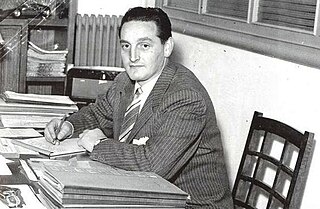
Volkswagen is a German automobile manufacturer based in Wolfsburg, Lower Saxony, Germany. Established in 1937 by the German Labour Front under the Nazi Party, it was revitalized into the global brand it is today after World War II by British Army officer Ivan Hirst. The company is well known for its iconic Beetle and serves as the flagship marque of the Volkswagen Group, which became the world's largest automotive manufacturer by global sales in 2016 and 2017.

The Volkswagen Karmann Ghia are a family of three overlapping sports car models produced by Volkswagen, marketed in 2+2 coupe (1955–1975) and 2+2 convertible (1957–1975) body styles, though German production ended one year before that in Brazil. Internally designated the Type 14 (1955–1975), the Type 34 (1962–1969), and the Type 145 TC, the Karmann Ghia cars combined the floorpans and mechanicals of the Type 1 / Beetle or Type 3 'ponton' models with styling by Italy's Carrozzeria Ghia, and hand-built bodywork by German coachbuilding house Karmann.

Puma Automóveis Ltda. is a Brazilian manufacturer of sports cars. It was established in 1963 as Sociedade de Automóveis Lumimari, then became Puma Veículos e Motores the following year, and Puma Indústria de Veículos SA in 1974.
Wilhelm Karmann GmbH, commonly known as Karmann, was a German automobile manufacturer and contract manufacturer based in Osnabrück, Germany. Founded by Wilhelm Karmann in 1901, the company specialised in various automotive roles, including design, production and assembly of components for a wide variety of automobile manufacturers, including Chrysler, Porsche, Mercedes-Benz and Volkswagen Group.

Virgil Max "Ex" Exner Sr. was an automobile designer for several American automobile companies, most notably Chrysler and Studebaker.

The Volkswagen Type 3 is a compact car manufactured and marketed by Volkswagen from 1961 to 1973. Introduced at the 1961 Frankfurt International Motor Show, the IAA, the Type 3 was marketed as the Volkswagen 1500 and later as the Volkswagen 1600, in two-door notchback, fastback, and station wagon body styles, the latter marketed as the 'Squareback' in the United States.

In automotive design, an RR, or rear-engine, rear-wheel-drive layout places both the engine and drive wheels at the rear of the vehicle. In contrast to the RMR layout, the center of mass of the engine is between the rear axle and the rear bumper. Although very common in transit buses and coaches due to the elimination of the drive shaft with low-floor buses, this layout has become increasingly rare in passenger cars.

The Ascort was an automobile manufactured by Continental Coachwork of Sydney, Australia from 1958 to 1960.

The Volkswagen Type 2 (T3) was the third generation of the Volkswagen Transporter and was marketed under various nameplates worldwide – including the Transporter or Caravelle in Europe, T25 in the UK but technically incorrect, Microbus and Kombi in South Africa/Brazil/Australia, Kampeerauto in Netherlands, Combi in France and Vanagon in North and South America.

The Volkswagen Type 181 is a two-wheel drive, four-door convertible, manufactured and marketed by Volkswagen from 1968 until 1983. Originally developed for the West German Army, the Type 181 also entered the civilian market as the Kurierwagen in West Germany, the Trekker in the United Kingdom, the Thing in the United States and Canada (1973–74), the Safari in Mexico and South America, and Pescaccia in Italy. Civilian sales ended after model year 1980.

A custom car is a passenger vehicle that has been altered to improve its performance, change its aesthetics, or combine both. Some automotive enthusiasts in the United States want to push "styling and performance a step beyond the showroom floor - to truly craft an automobile of one's own." A custom car in British usage, according to Collins English Dictionary, is built to the buyer's own specifications.

The Volkswagen Brasília is a rear-engined compact car developed by Volkswagen do Brasil and internally designated as the Type 321. Named for Brazil's capital city, the car was manufactured and marketed by Volkswagen in Brazil from 1973 to 1982; in Mexico from 1975 to 1982; and built from knock down kits in Nigeria, where it was marketed as the Igala from 1976 to 1980.

The Volkswagen SP2 is a sports car that was developed by Volkswagen do Brasil and built from July 1972 until December 1975. It is based on the chassis of the Brazilian market Volkswagen Type 3. "SP" is said to be an initialism of São Paulo, where the car was built, or of "sports prototype". In its issue of 20 June 1973, German technology magazine Hobby called the SP2 the "most beautiful Volkswagen in the world".

The Avenger GT was a kit car produced by Fiberfab. It was designed in California and manufactured in the United States and Canada for 12 years, from late 1966 until 1978.

Luigi "Gigi" Segre was an Italian automotive designer noted for his business and engineering acumen during his stewardship and ownership of Carrozzeria Ghia (1953–63), one of an Italy's premier automobile design and coachbuilders.

In automobile design, a rear-engine design layout places the engine at the rear of the vehicle. The center of gravity of the engine itself is behind the rear axle. This is not to be confused with the center of gravity of the whole vehicle, as an imbalance of such proportions would make it impossible to keep the front wheels on the ground.

The Volkswagen Type 147 was a panel van produced by the German automaker Volkswagen Commercial Vehicles from 1964 until 1974. The van was mainly built for the purposes of the state-owned Deutsche Bundespost.

A Cal looker is any air-cooled Volkswagen modified in fashion originating in Orange County, California in the late 1960s.

Karosserie Friedrich Rometsch, a German metallurgical-coachbuilding company based in Berlin-Halensee, Nestorstrasse 41, manufactured, modified, and repaired coaches, trailers, bodies and chassis.

Wilhelm Karmann Jr. was a German entrepreneur. He took over the management of Wilhelm Karmann GmbH based in Osnabrück in 1952 and led the company to become a recognized partner of the automotive industry as a contract manufacturer of complete vehicles and as a supplier of pressed parts, production systems and roof modules for convertibles. He was also involved in numerous vehicle developments.



















